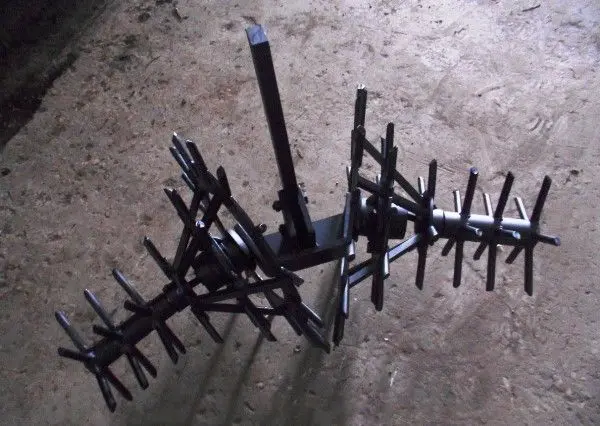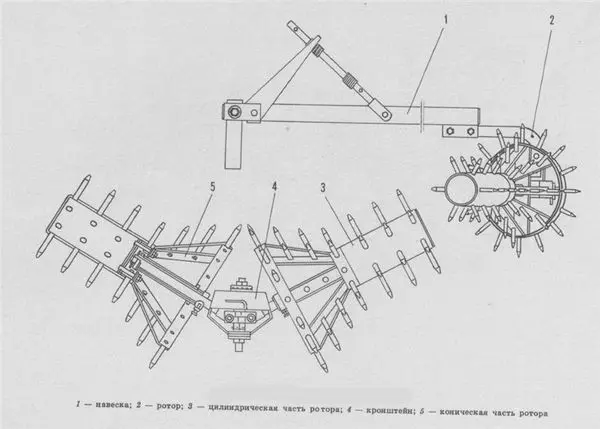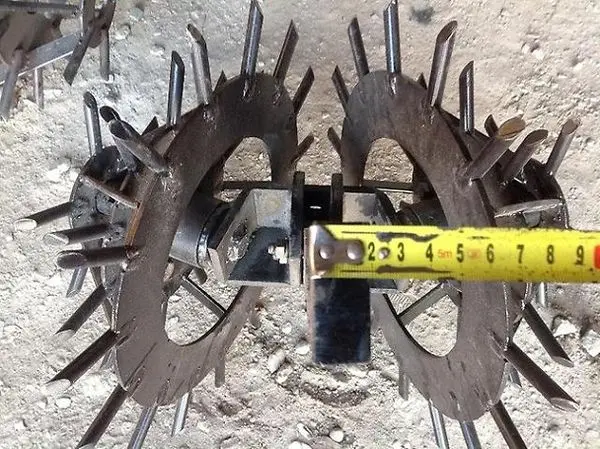Contents


The potato hedgehog is a practical agricultural tool that performs several important tasks at once. Depending on the model, this device can be a walk-behind tractor suspension or a manual fixture. Consider the purpose and functions of this tool, and also learn how to make hedgehogs for processing potatoes with your own hands.
Why do we need hedgehogs for potatoes

Hedgehogs perform the following functions:
- Clean the beds of weeds, removing them along with the roots.
- At the time of work, moles and rodents are repelled. A number of harmful insects are brought to the surface, after which they are eaten by birds.
- They loosen the soil, providing a better flow of air and water to the roots.
- Bushes are spudding.
Video “Do-it-yourself hedgehogs for weeding potatoes”
In this video you will learn how to make your own potato weeding hedgehogs.
Structural features
The potato hedgehog consists of spiked rings assembled on an axle and attached to a frame with a handle. Depending on the model, the rings can be of the same or different diameters.
Drawings of hedgehogs for processing potatoes can be both simple and very complex. Models consisting of two parts are popular – each is a cone of three rings of different diameters. Both parts are connected by a jumper and are located at an angle of 45°.
Spikes are most often made from straight metal rods 5–10 cm long, but sometimes they can be dagger-shaped. Sometimes discs are metal plates in the form of stars with pointed edges. In some cases, cones are made of rods and spikes are welded to them.
There are two main types of this device:
- Hand hedgehogs are attached to a wooden or metal handle. This is a good choice for small farms. The edges of the working part in them usually have the same diameter. Using this design requires much less physical effort.
- Mounted hedgehogs have a mount designed to be attached to a walk-behind tractor, cultivator or tractor. Designed for processing large areas. Most often they are made cone-shaped, which contributes to additional hilling.

Independent production of a manual cultivator
Now let’s look at how to make a hedgehog for processing potatoes with your own hands.
Preparatory stage
To make a homemade hand hedgehog you will need:
- metal pipe with a diameter of 15 cm;
- metal rod;
- bearings;
- metal rods with a diameter of 8 mm;
- pipe for the frame;
- corners;
- wooden handle.
Of the tools required:
- welding machine;
- Bulgarian;
- metal cutter.
Step by step manufacturing process

Consider the plan for making a simple hedgehog:
- Cut off a piece of pipe that will act as an axle. Choose the length according to the size of the row spacing on your site.
- Cut spikes 6-7 cm long from rods. They can be further sharpened at an angle of 45 ° on one side.
- Weld the spikes to the pipe so that they form several circles at a distance of about 4 cm from each other. There should be approximately 5 spikes per circle.
- Make a U-shaped spacer frame from a pipe. The length of the legs should be 34–36 cm so that the spiked pipe can rotate without interference. Punch holes on the ends of the legs.
- You can insert a rod and bearings into the pipe, or simply weld the edges with plugs with 1,6 cm pins.
- Assemble the structure by inserting the pins or the ends of the rod into the frame holes. Weld the corners to the frame, fasten a wooden handle between them.
When using such a device, it is pushed with force in front of you. The spikes should stick into the ground.
Hedgehogs for a walk-behind tractor
Making a suspended structure with your own hands is much more difficult. In addition, this is fraught with risk – there is a danger of damaging the equipment itself.
If you are confident in your abilities and want to try, carefully consider the drawing of the future design and its dimensions. For a large hedgehog, you can use wheels of 30, 20 and 10 cm, for a small one – 24, 17 and 10 cm.
For example, consider the first option:
- Cut out two rings from a metal sheet with an outer diameter of 30 cm and an inner diameter of 20 cm. The circles cut from the center will become medium-sized rings – small circles with a diameter of 10 cm are cut out of their center. Finally, in small circles, make a hole for the pipe 1 mm larger than it diameter.
- Prepare two pieces of pipe. Dial three rings on each – weld the small ones, and connect the medium and large ones with knitting needles. The distance between the large and small discs should be 17–18 cm.
- Cut 24 jumpers from a steel strip. Connect them with large and medium rings – 8 pcs. for every couple. Then connect the medium and small rings – 4 pcs. for a couple.
- Cut 80-90 spikes 12 cm long. Weld them to the discs – at least 15 for large ones, 10 for medium ones and 5 for small ones. If desired, there may be more. You can also add spikes to the jumpers.
- Bend the blank for the bracket in the shape of the letter P. Make holes for the axles in it.
- Insert rods with bearings into the pipes. Place the ends of the rods on the side of the large rings into the holes on the bracket and secure them with bolts or welding. Between themselves, both hedgehogs should be located at an angle of 45 °.
- To reduce the load on the structure, two guide wheels can be added to the bracket.
It is recommended to test the finished structure first on an empty site.
Regular processing of beds with hedgehogs can significantly increase the yield of potatoes. In addition, it reduces the number of weeds and improves the condition of the soil, which has a beneficial effect on the condition of the site as a whole.
Author: Svetlana Galitsina
Loading…









